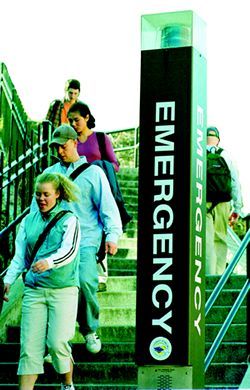Solar Orchards in the Outback

At Broken Hill there will be 42 solar dishes. South Australia’s facility will have ten. The word “farms” is used because the dishes, in rows mounted on poles, resemble orchards from a distance. Officials in Canberra, the national capital, say the two are intended as prototypes for far larger farms to meet the power needs of isolated communities. The technology was developed by an Australian company, Solar Systems Limited. It involves using solar dishes, more sophisticated than panels commonly in use, which track the sun as it moves through the sky. Each dish magnifies the intensity of the sun by 500 times and focuses the rays onto high-efficiency solar cells.
“Solar energy is a renewable source which doesn’t produce pollution, carbon dioxide or noise,” says federal environmental minister Robert Hill. What’s more, it isn’t “susceptible to the same price fluctuations as other energy resources.”
Bioengineered Salmon: Fish or Foul?

The rapid growth rate can help cut the costs of farming salmon, but the FDA must consider three criteria: Are bioengineered salmon safe to eat? Does the process harm the fish itself? And will they harm the environment? It is the last question that is the focus of most of the controversy. Opponents, who have labeled transgenic salmon “frankenfish” say the engineered variety could mate with and contaminate wild salmon.
Not so, says A/F Proteins. They note that in ocean waters, 99 percent of the fish will be sterile, and if the other one percent managed to mate with wild salmon, the offspring wouldn’t survive a winter. Proponents claim that biofish could help ease food shortages in Third World countries, and also help meet demand in Western countries.
Salmon farmers have not universally welcomed genetically modified fish, because they worry that prices could plummet. But Aqua Bounty Farms says that orders for biotech salmon eggs are strong and that farmers are interested in any product that helps cut costs. Even if the FDA approves the fish, there’s no guarantee that consumers will accept it. The FDA itself notes that “ethical concerns among the public over the appropriate use of animals are issues, not evident with transgenic plants, that may affect public acceptance of transgenic animals as food sources.” If Aqua Bounty Farms’ salmon do reach American consumers next year, it could be a harbinger of other, new biotech animal products. The FlavrSavr tomato, engineered to have a long shelf life, was such a pioneering product. But, then again, it bombed with the public.
Crime Stats Go Online

Boston College students pass an emergency call box on the Newton, Mass. campus.
In October, the federal government began publishing crime statistics from more than 6,000 universities and colleges for the first time, posting the data on the Internet. Now when prospective students and their parents begin the process of selecting a school, crime can be another factor in their equations. But the stats, of course, are no guarantee. When Eric Franklin Plunkett, a freshman at Gallaudet University, a school of 1,700 for the deaf in Washington, D.C., was found bludgeoned to death in his dormitory room last September, it was only weeks after he waved goodbye to his mother and told her not to worry, that he would be fine. The school’s crime record over the past three years would have underscored his confidence. The numbers indicate that Gallaudet is no hotbed of crime. Last year, there were four reported rapes, one robbery, 15 burglaries, four aggravated assaults, one car theft, and one reported case of arson.
Colleges have long been accused of playing down campus crime and underreporting events. Congress passed a law requiring better posting of crime stats in 1990—the so-called Clery Act, named after Jeanne Clery, 19, a student who was raped and murdered in 1986 at Lehigh University in Bethlehem, Pa. Congress tightened the law in 1997, after determining that schools were still doing a poor job in making the numbers available and that many were ignoring the law. Now noncompliance can result in fines of $25,000.
A watchdog group set up by the Clery family, Security on Campus, wants the Department of Education to ensure the accuracy of the campus reports by random auditing. Otherwise, it claims, schools will continue to underreport crimes.
To test the site, www.ope.ed.gov/security, Prism searched for all U.S. schools with engineering programs. From the resulting list of several hundred schools, three schools of different sizes were selected. At the Michigan Technological University, a school of 6,257 in rural Michigan, there were three instances of nonforcible sex, three burglaries, and one car theft in 1999. Florida Agricultural and Mechanical University, in Tallahassee, which has 11,828 students, last year reported two rapes, four robberies, 13 aggravated assaults, 73 burglaries, 22 car thefts, and six arsons. And the State University of New York at Buffalo, which has 23,370 students, recorded 13 rapes, 18 robberies, 20 assaults, 330 burglaries, 29 stolen cars, and eight instances of arson. Meanwhile, the school that inadvertently became central to the campaign to publish crime stats, Lehigh University, which has 6,363 students—is not crime-ridden, either. It reported four rapes, six aggravated assaults, six burglaries and three auto thefts last year.
Overall, it would seem institutions have little to fear in shedding more light on their crime numbers because American campuses, while not crime-free, are often oases of relative safety.
Category: Briefings